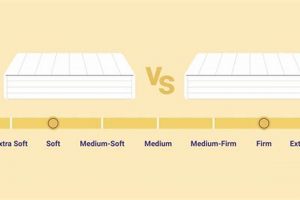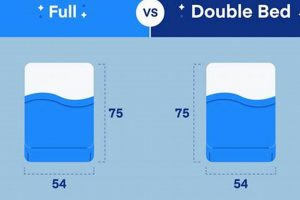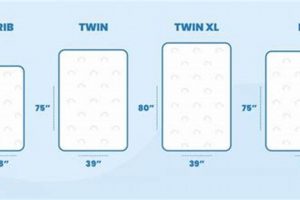The selection of a mattress often involves evaluating different levels of support and surface feel. Two common options represent distinct approaches to comfort. One provides a balance between cushioning and resistance, conforming to the body while still offering underlying stability. The other prioritizes a more solid, unyielding surface, minimizing sinkage and promoting spinal alignment for some individuals.
The choice between a softer or harder sleeping surface is significant because it affects sleep quality and musculoskeletal health. Historically, preferences have varied based on cultural norms and evolving understandings of ergonomics. Today, individuals consider factors such as sleeping position, body weight, and any existing physical conditions when determining the appropriate level of support.
Understanding the nuances of each option is crucial for selecting a mattress that promotes restorative sleep and long-term well-being. The following sections will delve into the specific characteristics, advantages, and disadvantages of each type, providing a detailed comparison to aid in informed decision-making.
Guidance on Selecting a Mattress Based on Support Level
The subsequent recommendations aim to facilitate the selection of a mattress that aligns with individual needs and preferences regarding firmness and support. These guidelines emphasize factors crucial for optimal sleep and physical well-being.
Tip 1: Consider Sleeping Position: Individuals who primarily sleep on their back or stomach may benefit from a more supportive surface, potentially minimizing spinal misalignment. Those favoring a side-sleeping posture might find a more conforming surface advantageous, allowing for shoulder and hip pressure relief.
Tip 2: Evaluate Body Weight: Individuals with higher body weight generally require a firmer sleeping surface to prevent excessive sinkage and maintain proper spinal alignment. Conversely, those with lower body weight might find a more moderate surface more comfortable and supportive.
Tip 3: Assess Existing Physical Conditions: Individuals with pre-existing back pain or other musculoskeletal conditions should consult with a healthcare professional to determine the optimal firmness level for their specific needs. A mattress that exacerbates existing conditions should be avoided.
Tip 4: Request a Trial Period: Many mattress retailers offer trial periods, allowing consumers to test the product at home for a specified duration. This is an invaluable opportunity to assess comfort and support over an extended period.
Tip 5: Inquire About Construction and Materials: The materials and construction of a mattress significantly impact its firmness and durability. Understanding the composition of the mattress can aid in predicting its long-term performance and suitability.
Tip 6: Research Density and ILD Ratings: The density of the foam layers and the Indentation Load Deflection (ILD) rating provide objective measures of firmness and support. Higher ILD values typically indicate a firmer surface.
The selection of an appropriate sleeping surface necessitates careful consideration of individual factors. Adherence to these guidelines can enhance the likelihood of selecting a mattress that promotes restful sleep and optimal physical well-being.
The final section will synthesize the key findings presented, providing a concise overview to reinforce the importance of informed mattress selection.
1. Spinal alignment
Spinal alignment is a critical factor when evaluating the suitability of different mattress firmness levels. The objective is to maintain the natural curvature of the spine during sleep, preventing excessive strain and promoting musculoskeletal health. The selection between options significantly influences the attainment of this goal. A surface that is excessively soft can allow the spine to sag, leading to discomfort and potential long-term issues. Conversely, one that is excessively rigid may fail to conform to the body’s contours, resulting in pressure points and inadequate support. The ideal choice facilitates neutral spinal positioning, irrespective of sleeping posture.
For instance, consider an individual who primarily sleeps on their back. A medium mattress might provide insufficient support, causing the lower back to compress. In contrast, a firmer model could offer the necessary resistance to prevent this compression, thereby maintaining alignment. Conversely, a side sleeper may find that a rigid surface creates excessive pressure on the shoulder and hip, potentially leading to pain and discomfort. Here, a medium-firm option might be preferable, allowing for some contouring while still providing adequate support. The relationship between body weight and mattress firmness is also crucial; individuals with higher body mass typically require more substantial support to prevent spinal misalignment.
Ultimately, the link between spinal alignment and mattress firmness is complex and individual-specific. There is no universally optimal choice. A thorough understanding of one’s sleeping position, body weight, and any pre-existing musculoskeletal conditions is essential for making an informed decision. Moreover, trialing different firmness levels, when possible, can provide valuable insights into personal comfort and support preferences. The overriding aim is to select a mattress that minimizes spinal stress and promotes restorative sleep.
2. Pressure point relief
Pressure point relief is a primary consideration in mattress selection, directly influencing sleep comfort and overall well-being. It refers to the ability of a mattress to minimize concentrated pressure on specific areas of the body, such as the shoulders, hips, and knees, during sleep. The effectiveness of pressure point relief is intrinsically linked to mattress firmness.
- Conforming Properties
Softer surfaces, generally associated with medium firmness, tend to conform more closely to the body’s contours. This conforming action distributes weight more evenly, reducing peak pressure on prominent bony areas. Consequently, a medium mattress may be advantageous for individuals who experience discomfort due to pressure buildup during sleep, particularly side sleepers who place considerable weight on the shoulder and hip.
- Surface Firmness and Weight Distribution
Firmer surfaces, conversely, resist compression and provide more uniform support across the entire body. While this can be beneficial for spinal alignment, it may also increase pressure on specific contact points if the body cannot sink slightly into the surface. A firm mattress, therefore, might not be ideal for individuals sensitive to pressure buildup, potentially leading to discomfort or restless sleep.
- Material Composition
The materials used in mattress construction significantly influence pressure relief capabilities. Memory foam, for example, is known for its viscoelastic properties, allowing it to contour to the body and distribute weight effectively. Latex, another common material, offers a more responsive conforming action. The choice of material can thus impact the extent to which a mattress alleviates pressure points.
- Sleeping Position Considerations
Sleeping position plays a crucial role in determining the need for pressure point relief. Side sleepers typically require more cushioning in the shoulder and hip areas to prevent discomfort. Back sleepers generally benefit from a balance of support and pressure relief to maintain spinal alignment without excessive pressure. Stomach sleepers may require a firmer surface to prevent excessive sinkage and maintain proper spinal alignment, thereby minimizing pressure on the ribcage and abdomen.
The optimal mattress firmness for pressure point relief is highly individual and depends on factors such as sleeping position, body weight, and personal sensitivity. A careful evaluation of these factors, along with consideration of mattress material and construction, is essential for selecting a mattress that effectively minimizes pressure and promotes restorative sleep.
3. Sleeping position
Sleeping position significantly influences the suitability of different mattress firmness levels. The alignment of the spine, the distribution of body weight, and the potential for pressure point development vary depending on whether an individual sleeps on their back, side, or stomach. Consequently, the ideal mattress firmness for a back sleeper may differ substantially from that of a side or stomach sleeper.
Back sleepers generally require a mattress that provides adequate support to maintain the natural curvature of the spine. A surface that is too soft can allow the hips to sink excessively, leading to lower back pain. Conversely, a mattress that is too firm may fail to conform to the contours of the spine, resulting in pressure points. A medium-firm mattress often strikes a balance, providing sufficient support while still offering some degree of cushioning. For instance, a person experiencing lower back pain who sleeps on their back may find that a firm mattress alleviates their symptoms by preventing spinal misalignment. Side sleepers, in contrast, typically benefit from a mattress that offers more pressure relief, particularly in the shoulder and hip areas. A surface that is too firm can create concentrated pressure, leading to discomfort and restless sleep. A medium mattress allows the shoulder and hip to sink slightly, distributing weight more evenly and reducing pressure. As an illustration, a side sleeper with broad shoulders may find a medium mattress more comfortable because it allows the shoulder to sink in, maintaining spinal alignment. Stomach sleepers often require a firmer mattress to prevent excessive sinkage in the midsection, which can lead to spinal strain. A firm mattress provides the necessary support to maintain a relatively straight spinal alignment. However, some stomach sleepers may find a medium-firm mattress more comfortable if it provides a slight degree of cushioning while still offering adequate support.
Therefore, the selection of a mattress necessitates careful consideration of one’s predominant sleeping position. While individual preferences and body weight also play a role, understanding the biomechanical implications of different sleeping positions is crucial for selecting a mattress that promotes optimal spinal alignment and comfort. This connection is essential for achieving restful sleep and minimizing the risk of musculoskeletal issues.
4. Body weight
Body weight exerts a significant influence on the perceived comfort and support derived from a mattress, directly impacting the optimal firmness level for an individual. A mattress that provides adequate support for one person may prove entirely unsuitable for another due to differences in body mass. Consequently, careful consideration of body weight is paramount when selecting between firmness options.
- Support and Sinkage
Individuals with higher body weights require mattresses that offer substantial support to prevent excessive sinkage. Excessive sinkage can lead to spinal misalignment, pressure point development, and a general feeling of being “swallowed” by the mattress. Therefore, firmer surfaces are often recommended for heavier individuals to maintain proper spinal alignment and prevent discomfort.
- Pressure Distribution
Body weight affects the distribution of pressure across the mattress surface. Lighter individuals distribute their weight over a smaller area, potentially requiring a softer surface to conform to their body contours and alleviate pressure points. In contrast, heavier individuals distribute their weight over a larger area, necessitating a firmer surface to provide adequate support and prevent excessive pressure on specific areas such as the hips and shoulders.
- Mattress Durability
Body weight can impact the long-term durability of a mattress. Mattresses subjected to higher weights may experience faster wear and tear, particularly if they lack sufficient support. Selecting a mattress with robust construction and high-density materials is crucial for individuals with higher body weights to ensure longevity and maintain optimal performance over time.
- Perceived Comfort
Ultimately, the perceived comfort of a mattress is subjective and influenced by individual preferences. However, body weight plays a significant role in determining whether a particular firmness level feels comfortable. A mattress that is too soft may feel unstable and unsupportive for a heavier person, while one that is too firm may feel unyielding and uncomfortable for a lighter person. Balancing support and comfort based on body weight is essential for selecting a mattress that promotes restful sleep.
In conclusion, the relationship between body weight and mattress firmness is critical for ensuring optimal sleep quality and physical well-being. Selecting a mattress that provides adequate support, distributes pressure effectively, and maintains durability is essential for individuals of all body weights. This careful evaluation ensures a comfortable and restorative sleep experience, tailored to individual needs and preferences.
5. Individual preferences
The subjective element of personal preference plays a definitive role in the selection between distinct mattress firmness levels. While objective factors such as spinal alignment and pressure relief are critical, the final decision often rests on individual perception of comfort and preferred sleeping experience.
- Habitual Sleep Surface
Prior experience with specific mattress types significantly shapes preference. Individuals accustomed to a softer sleeping surface may initially find a firmer mattress uncomfortable, while those accustomed to a firmer surface may perceive a softer mattress as lacking support. This familiarity effect often influences initial comfort assessments and long-term satisfaction.
- Sensory Thresholds
Variations in sensory thresholds influence sensitivity to pressure and support. Some individuals possess a higher tolerance for pressure, making a firmer mattress tolerable or even preferable. Others exhibit greater sensitivity, necessitating a more conforming surface to minimize discomfort. These sensory differences contribute to the diverse range of firmness preferences.
- Psychological Associations
Psychological associations with different firmness levels can impact preference. A softer mattress might be associated with feelings of luxury and relaxation, while a firmer mattress might be linked to concepts of stability and support. These psychological factors, though often subconscious, can influence the perceived comfort and desirability of different options.
- Influence of Marketing and Social Factors
Marketing campaigns and social trends can shape expectations and preferences for mattress firmness. Exposure to advertisements emphasizing the benefits of specific firmness levels, or influence from peers and social media, can sway individual perceptions and purchasing decisions, regardless of objective suitability.
These facets underscore the intrinsic subjectivity involved in mattress selection. While physiological considerations provide a framework for optimal support, individual preferences ultimately dictate the most satisfying sleeping experience. Acknowledging and respecting these individual variations is essential for achieving long-term comfort and restful sleep. Consequently, informed decision-making requires both objective analysis and subjective introspection.
6. Back pain considerations
Back pain fundamentally alters the selection process when determining appropriate mattress firmness. The presence of chronic or acute back pain introduces specific biomechanical requirements for spinal support and pressure distribution, necessitating careful consideration of mattress characteristics. The primary goal becomes alleviating pain and promoting spinal alignment to facilitate restorative sleep.
The impact of mattress firmness on back pain is multifaceted. For some individuals, a firmer mattress provides adequate support to prevent spinal misalignment, reducing strain on the lumbar region. Conversely, a surface that is too rigid may exacerbate pain by creating pressure points and restricting natural movement. Other individuals may find that a medium mattress offers a more comfortable balance, providing some degree of cushioning while still maintaining support. For instance, a person with spinal stenosis may benefit from a medium-firm surface that prevents excessive spinal flexion. Conversely, someone with muscle spasms may find that a firmer mattress aggravates their condition by preventing relaxation. A mattress that fails to properly support the spine can lead to increased muscle tension, nerve compression, and inflammation, all of which contribute to back pain. Therefore, a trial period is advantageous to assess the mattress’s effect on pain levels over several nights.
Ultimately, mattress selection in the context of back pain requires a personalized approach, often involving consultation with a healthcare professional. There is no universal recommendation, and the ideal firmness level depends on the specific cause and nature of the back pain, individual sleeping position, and body weight. Prioritizing spinal alignment and pressure relief are essential, and informed decision-making should be guided by both objective assessment and subjective comfort evaluation. This targeted approach is more likely to result in a mattress that promotes pain reduction and improved sleep quality.
7. Mattress durability
Mattress durability, a crucial consideration for consumers, is directly influenced by the firmness level chosen. The interaction between mattress firmness and longevity encompasses factors related to material composition, construction techniques, and long-term performance under varying levels of stress. The initial selection of firmness impacts the overall lifespan and sustained comfort of the product.
- Material Density and Compression
Firmer mattresses typically employ higher-density materials to achieve their characteristic support. Increased material density generally translates to improved resistance to compression over time. The denser the material, the slower the rate of degradation under consistent weight and pressure. Medium mattresses, often utilizing less dense materials for added comfort, may exhibit greater compression and a reduced lifespan compared to their firmer counterparts. For example, a high-density foam core in a firm mattress will likely resist sagging and maintain its shape for a longer period than a less dense core in a medium mattress.
- Support Core Integrity
The integrity of the mattress’s support core is fundamental to its long-term durability. Firmer mattresses, designed to offer substantial support, often feature reinforced core structures. These structures may include heavier-gauge coils, denser foam layers, or enhanced edge support systems. The reinforced core minimizes the risk of sagging and maintains uniform support across the mattress surface, prolonging its usability. Medium mattresses, prioritizing comfort and conformity, may lack the same level of core reinforcement, potentially leading to premature wear and a decline in support over time.
- Surface Layer Resilience
The resilience of the surface layers, which provide initial comfort and cushioning, also impacts overall durability. Firmer mattresses, while offering less initial conformity, often exhibit greater resistance to indentation and surface wear. The tighter cell structure of firmer foams minimizes the effects of repeated compression and prevents the formation of body impressions. Medium mattresses, with their softer surface layers, may be more susceptible to indentation and surface degradation, particularly under concentrated pressure points. This variance in surface layer resilience contributes to the differing lifespans observed between firmness levels.
- Weight Distribution and Stress
The manner in which a mattress distributes weight and handles stress contributes significantly to its durability. Firmer mattresses, designed to distribute weight more evenly, minimize localized stress on individual components. This uniform weight distribution reduces the likelihood of premature wear and prolongs the mattress’s lifespan. Medium mattresses, allowing for greater sinkage and conformity, may concentrate stress on specific areas, potentially accelerating the degradation of those regions. Effective weight distribution is a key factor in determining the long-term performance and durability of a mattress, regardless of its firmness level.
The durability of either a medium or firm mattress is dependent on a complex interplay of material quality, construction techniques, and the level of stress it endures over time. While firmer mattresses often exhibit inherent advantages in terms of resistance to compression and core support, advancements in material science and manufacturing processes have improved the longevity of medium mattresses. Consumers should carefully consider these factors, alongside their individual comfort preferences, when selecting a mattress designed to provide sustained support and lasting value.
Frequently Asked Questions
The following questions and answers address common inquiries regarding mattress firmness levels and their suitability for different individuals and circumstances.
Question 1: Is a firmer mattress always better for back pain?
A firmer mattress is not universally superior for back pain. While it can provide enhanced support and prevent spinal misalignment for some, it may exacerbate pain for others by creating pressure points. The ideal firmness depends on the underlying cause of the back pain and individual preferences.
Question 2: How does body weight influence the optimal mattress firmness?
Individuals with higher body weights generally require firmer mattresses to prevent excessive sinkage and maintain proper spinal alignment. Lighter individuals may find medium mattresses more comfortable and supportive.
Question 3: Does sleeping position dictate the best mattress firmness?
Sleeping position is a key factor. Side sleepers often benefit from medium mattresses that offer pressure relief for the shoulders and hips. Back and stomach sleepers may prefer firmer surfaces for optimal spinal support.
Question 4: How can one assess mattress firmness before purchasing?
Testing the mattress in-store is recommended. Lie in various sleeping positions to evaluate comfort and support. If possible, inquire about trial periods to assess the mattress at home over a longer duration.
Question 5: What role does material composition play in mattress firmness?
Material composition significantly affects firmness. Memory foam typically provides conforming support, while latex offers a more responsive feel. Innerspring mattresses vary in firmness depending on coil gauge and density.
Question 6: Is mattress durability affected by firmness level?
Mattress durability can be influenced by firmness. Firmer mattresses often utilize denser materials that resist compression over time. However, high-quality medium mattresses can also offer excellent durability with proper construction.
The selection of mattress firmness necessitates consideration of individual needs and preferences. These FAQs provide a foundation for informed decision-making.
The succeeding section delves into specific product recommendations based on the criteria discussed.
medium vs firm mattress
The preceding exploration has detailed the distinct characteristics of differing support levels. The analysis has shown that the selection of either option necessitates a careful evaluation of individual factors including body weight, sleeping position, pre-existing conditions, and subjective comfort preferences. While general guidelines exist, a universally optimal sleeping surface remains elusive. Key considerations discussed involved spinal alignment, pressure point relief, and long-term durability, highlighting the multifaceted nature of informed mattress selection.
Ultimately, the decision regarding surface firmness represents a commitment to long-term physical well-being. Prioritizing informed decision-making, encompassing both objective analysis and subjective assessment, remains paramount. Continued research and personalized evaluation are crucial for optimizing sleep quality and maximizing the restorative benefits of rest. Further consultation with healthcare professionals or sleep specialists may offer added clarity in particularly complex situations.





![Leesa vs Casper Mattress: Which Bed is Best [2024]? Organic & Natural Mattress Buyer’s Guide: Non-Toxic Sleep Solutions Leesa vs Casper Mattress: Which Bed is Best [2024]? | Organic & Natural Mattress Buyer’s Guide: Non-Toxic Sleep Solutions](https://mattressworldpa.com/wp-content/uploads/2025/07/th-1078-300x200.jpg)

